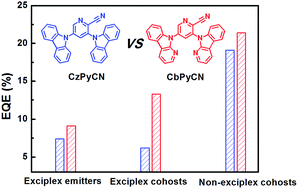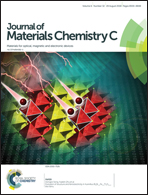Carbazole/α-carboline hybrid bipolar compounds as electron acceptors in exciplex or non-exciplex mixed cohosts and exciplex-TADF emitters for high-efficiency OLEDs†
Abstract
Two cyanopyridine derivatives CzPyCN and CbPyCN are designed and synthesized through a simple catalyst free aromatic nucleophilic substitution reaction by using 2-cyano-3,5-difluoropyridine as the electrophile and carbazole (Cz) or α-carboline (Cb) as the nucleophile. CbPyCN exhibits blue-shifted emission (λmax at 420 nm), a wider optical band-bap (Eg: 3.22 eV) and a higher triplet energy (ET: 2.79 eV) than CzPyCN (454 nm, 3.02 and 2.69 eV). The HOMO/LUMO energy levels were −5.77/−2.75 and −5.58/−2.38 eV for CzPyCN and CbPyCN, respectively. With enough HOMO/LUMO energy level offsets, CzPyCN and CbPyCN could function as electron acceptors to form an exciplex with a typical electron-donor, di-[4-(N,N-ditolyl-amino)-phenyl]cyclohexane (TAPC), showing broad exciplex emission with peaks at 530 and 520 nm, and long decay lifetimes of 1097 and 1014 ns, respectively. However, when mixed with 1,3-di(9H-carbazol-9-yl)-benzene (mCP), no exciplex but only typical CzPyCN or CbPyCN deep blue emission with a decay lifetime of 14.3 or 12.1 ns is observed. Blue phosphorescent OLEDs by using mCP (TAPC)/CzPyCN as mixed cohosts show a maximum EQE of 19.1 (6.2)%, lower than the 21.4 (13.3)% of mCP (TAPC)/CbPyCN, respectively, which is probably due to the better electron-transport properties and higher triplet energy levels for electron-deficient α-carboline containing CbPyCN. Similarly, exciplex-type green fluorescent OLEDs based on TAPC/CzPyCN show a lower maximum efficiency of 22.0 cd A−1 and 7.4% than 27.5 cd A−1 and 9.1% of TAPC/CbPyCN.



 Please wait while we load your content...
Please wait while we load your content...